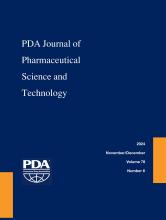Abstract
Isolators play a critical role in protecting both the product and the environment, as well as the personnel involved in pharmaceutical manufacturing, analytical procedures, and sterility testing. Gloves attached to the windows and doors of the isolator are designed to facilitate intervention, testing, and safety. However, due to their inherent characteristics and vulnerability to puncture or loss of integrity, they are recognized as a significant potential source of contamination. In addition to the possible pathways of contamination transfer, the size of glove holes plays a critical role in determining the risk of contamination. In this study, chlorosulphonated polyethylene (CSM) gloves were exposed to an aerosol containing Bacillus subtilis or Staphylococcus aureus. This assessment aimed to ascertain the integrity of the gloves' seal. It was postulated that, below a certain aperture size, gloves used in isolator systems could establish an effective seal even if the external surface of the gloves exhibited modifications. Calibrated holes of different diameters (0.3, 0.5, 1, and 1.5 mm) were created using a femtosecond laser drilling technology. The holes were located on the tip of the middle finger. Based on the context of our study, passage of microorganisms through glove holes of a certain size does occur. Under the experimental conditions chosen, the cutoff for passage was determined to be a 0.5-mm hole, regardless of the microorganism evaluated. Although this study has some limitations, including the lack of a panel of microorganisms evaluated and the investigation of a single glove type called CSM, the high level of “worst case” challenge conditions provides compelling data to support our results. It would now be interesting to carry out studies at different production sites to assess their risk of contamination and relate this to their glove failure.
- © PDA, Inc. 2024
PDA members receive access to all articles published in the current year and previous volume year. Institutional subscribers received access to all content. Log in below to receive access to this article if you are either of these.
If you are neither or you are a PDA member trying to access an article outside of your membership license, then you must purchase access to this article (below). If you do not have a username or password for JPST, you will be required to create an account prior to purchasing.
Full issue PDFs are for PDA members only.
Note to pda.org users
The PDA and PDA bookstore websites (www.pda.org and www.pda.org/bookstore) are separate websites from the PDA JPST website. When you first join PDA, your initial UserID and Password are sent to HighWirePress to create your PDA JPST account. Subsequent UserrID and Password changes required at the PDA websites will not pass on to PDA JPST and vice versa. If you forget your PDA JPST UserID and/or Password, you can request help to retrieve UserID and reset Password below.






